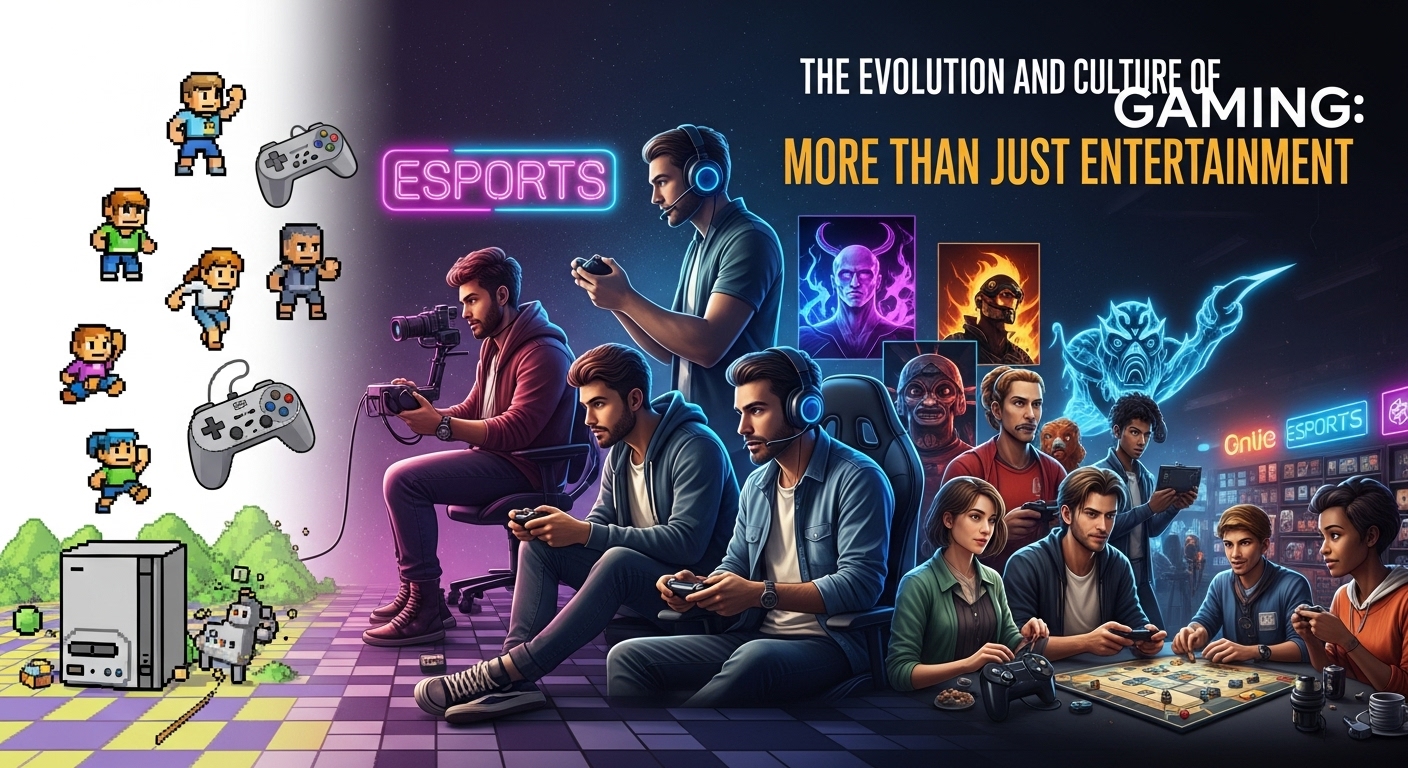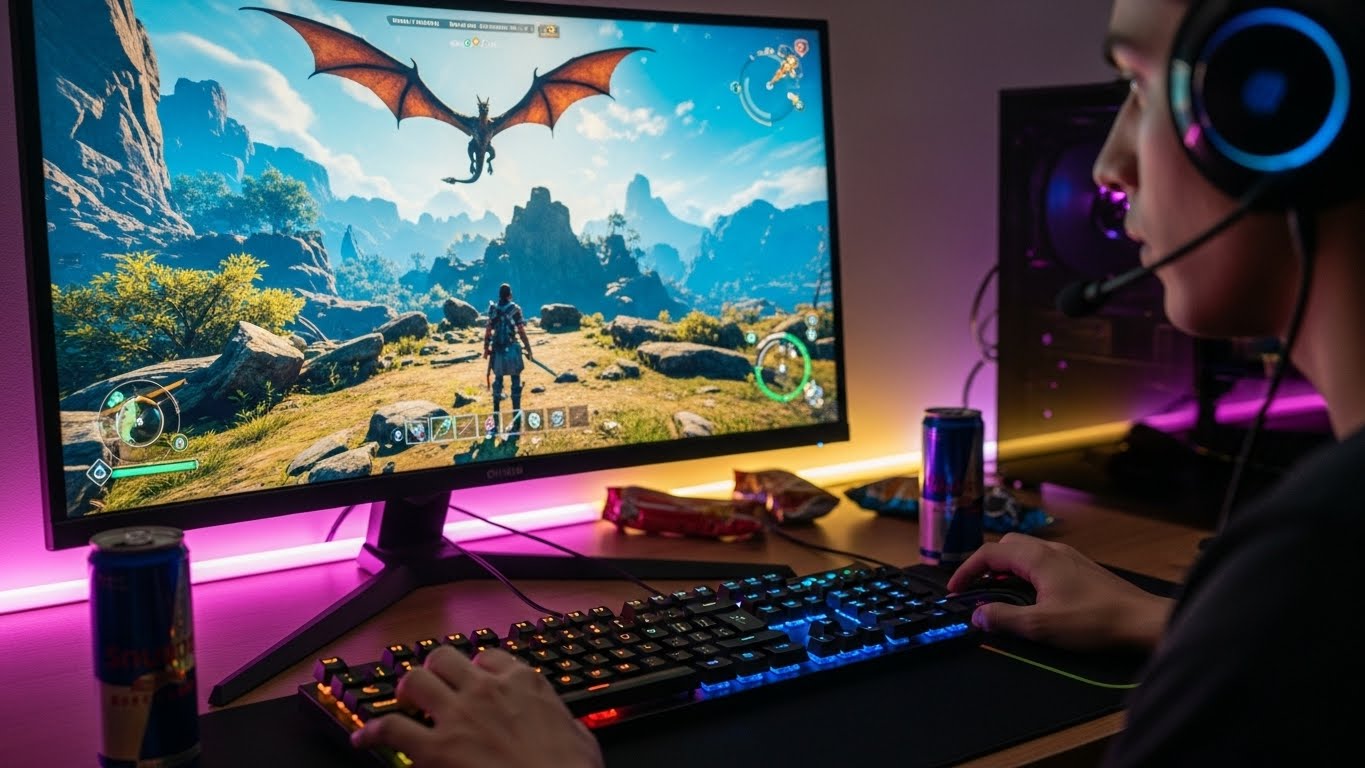Gaming is no longer just a pastime—it has become a cultural phenomenon, a technological powerhouse, and an art form in its own right. From the early days of simple pixelated graphics to the hyper-realistic, immersive worlds of modern video games, the evolution of gaming mirrors the rapid growth of technology and creativity in the digital age. In this blog post, we will explore the history, evolution, current trends, and future possibilities of gaming, as well as its impact on society and culture.
The Origins of Gaming
The roots of gaming stretch back to the 1950s and 1960s, when computer scientists began experimenting with digital entertainment. One of the earliest known examples is “Tennis for Two”, created in 1958 by physicist William Higinbotham. It was a simple tennis simulation displayed on an oscilloscope, designed to entertain visitors at a research laboratory. Around the same time, “Spacewar!”, created by Steve Russell in 1962, became a landmark in computer gaming, inspiring countless programmers and enthusiasts to explore digital entertainment.
The 1970s marked the birth of the arcade era. Games like Pong, released by Atari in 1972, brought interactive entertainment to the masses. Pong’s simple mechanics—players controlling paddles to hit a ball back and forth—captured the imagination of a generation and laid the foundation for the arcade boom. Following Pong, arcade machines like Space Invaders and Pac-Man transformed gaming into a social experience, attracting players to arcades where they could compete for high scores and share experiences with friends.
The Rise of Home Gaming Consoles
The late 1970s and early 1980s saw a major shift: gaming moved from arcades into the home. The release of the Atari 2600 in 1977 allowed players to enjoy their favorite games without leaving their living rooms. This era introduced iconic titles like Adventure, Pitfall!, and Pac-Man, cementing video games as a staple of popular culture.
During this time, gaming became more than a novelty—it began to shape lifestyles. Families gathered around consoles, and children spent hours exploring digital worlds, developing problem-solving skills, hand-eye coordination, and even storytelling abilities through gameplay. The early 1980s also witnessed the video game crash of 1983, a major setback caused by market saturation and poor-quality titles. However, this period of decline was temporary, and it ultimately paved the way for new innovation.
The Nintendo Revolution
The late 1980s and 1990s were dominated by Nintendo, a company that transformed gaming with its innovative consoles and beloved franchises. The Nintendo Entertainment System (NES), released in 1985, revived the home console market and introduced players to characters like Mario and Link. Nintendo focused on high-quality games with engaging stories, appealing visuals, and intuitive gameplay, setting a new standard for the industry.
The Super Nintendo Entertainment System (SNES) followed in 1990, delivering enhanced graphics, richer sound, and more complex games. Classics like The Legend of Zelda: A Link to the Past and Super Mario World offered immersive experiences that combined adventure, strategy, and creativity. Nintendo’s emphasis on family-friendly entertainment and innovative gameplay established it as a leader in the gaming world.
The Evolution of Graphics and Technology
As consoles advanced, so did the quality of graphics. The transition from 8-bit to 16-bit, and eventually to 32-bit and 64-bit systems, allowed developers to create more detailed environments and realistic characters. The 1990s saw the introduction of 3D graphics, which revolutionized gameplay and storytelling. Titles like Super Mario 64 and The Legend of Zelda: Ocarina of Time showcased the potential of three-dimensional worlds, offering players freedom of movement and unprecedented immersion.
PC gaming also flourished during this era. Games like Doom, Quake, and StarCraft pushed the boundaries of graphics, sound design, and multiplayer experiences. The rise of graphics cards and faster processors allowed computers to handle more complex calculations, enabling realistic physics, AI, and environmental effects. Gaming became a showcase for technological innovation, with developers constantly exploring new possibilities.
Online Gaming and Multiplayer Experiences
The late 1990s and early 2000s introduced a transformative element: online gaming. With the expansion of the internet, players could connect with others around the world, compete in multiplayer matches, and form communities. Games like EverQuest, Counter-Strike, and World of Warcraft demonstrated the power of online interaction, creating social ecosystems where friendships, rivalries, and collaborations flourished.
Online gaming also gave rise to esports, a competitive gaming culture where players and teams compete for recognition and prizes. Tournaments, leagues, and streaming platforms turned gaming into a spectator sport, attracting millions of viewers and legitimizing professional gaming careers. The accessibility of online multiplayer games changed the landscape of entertainment, allowing players to interact globally and form lasting connections.
Mobile Gaming and Accessibility
The 2010s marked the era of mobile gaming, driven by the widespread adoption of smartphones and tablets. Games like Angry Birds, Candy Crush, and Clash of Clans reached audiences who had never considered themselves gamers. Mobile gaming made entertainment accessible to anyone with a device, creating casual gaming experiences that could be enjoyed in short bursts or over long periods.
Mobile platforms also allowed developers to experiment with new genres, monetization models, and social features. Free-to-play games, microtransactions, and in-game events became standard, reshaping the industry’s economics. Gaming was no longer confined to consoles or PCs—it became an omnipresent part of daily life.
Virtual Reality and Immersive Experiences
In recent years, gaming has embraced cutting-edge technology to create fully immersive experiences. Virtual reality (VR) headsets like Oculus Rift, HTC Vive, and PlayStation VR transport players into three-dimensional worlds, where motion controllers, haptic feedback, and spatial audio enhance immersion. VR games challenge traditional gameplay design, requiring developers to rethink interaction, storytelling, and spatial awareness.
Augmented reality (AR) has also contributed to the evolution of gaming. Games like Pokémon GO blend digital elements with the real world, encouraging exploration, exercise, and social interaction. VR and AR demonstrate that gaming is not just entertainment—it is a platform for innovation, education, and creativity.
Storytelling and Narrative Depth
Modern gaming has become a storytelling medium rivaling film and literature. Titles like The Last of Us, Red Dead Redemption 2, and The Witcher 3 offer complex narratives, morally ambiguous choices, and richly detailed worlds. Players are no longer passive observers; they shape the story through decisions, exploration, and interactions with characters.
This narrative depth is enhanced by cinematic presentation, voice acting, and motion capture technology. Gaming has evolved into an art form that engages players emotionally, intellectually, and aesthetically, proving that video games can be more than entertainment—they can be profound experiences.
The Social and Cultural Impact of Gaming
Gaming has had a profound impact on society and culture. It has created global communities where players collaborate, compete, and share experiences. Gaming conventions, streaming platforms, and esports tournaments foster connection and celebration of shared passions.
Moreover, games have influenced other media, including movies, books, and music. Iconic franchises like Super Mario, Final Fantasy, and Halo have inspired films, novels, and merchandise, demonstrating gaming’s cultural significance. Gaming also serves as a platform for education, therapy, and social awareness, offering interactive simulations, problem-solving exercises, and inclusive representation.
Challenges and Controversies
Despite its positive aspects, gaming faces challenges and controversies. Concerns about addiction, screen time, and violent content have sparked debates about the medium’s impact on mental health and behavior. Monetization practices, such as loot boxes and microtransactions, have raised ethical questions regarding fairness and consumer protection.
Additionally, the gaming industry has faced issues related to diversity and inclusion, both in game content and workplace environments. Representation of gender, ethnicity, and disability continues to evolve, with developers and communities advocating for more inclusive and thoughtful portrayals.
The Future of Gaming
The future of gaming is filled with exciting possibilities. Artificial intelligence may create dynamic, responsive worlds where characters react realistically to player actions. Cloud gaming could allow players to access high-quality games on any device, eliminating the need for expensive hardware. Advances in VR, AR, and haptic technology will continue to push the boundaries of immersion.
Social and interactive experiences are also evolving. Multiplayer and cooperative gameplay will expand beyond traditional formats, creating persistent online worlds where players collaborate on massive projects or engage in global events. Storytelling will become more personalized, adapting narratives to individual player choices, playstyles, and emotional responses.
Furthermore, gaming may continue to intersect with education, healthcare, and social activism. Interactive simulations, serious games, and gamified learning could transform how people acquire skills, make decisions, and engage with real-world issues. Gaming is no longer just entertainment—it is a powerful tool for creativity, connection, and innovation.
Conclusion
From humble beginnings as simple pixelated experiments to the sophisticated, immersive experiences of today, gaming has undergone a remarkable transformation. It has become a cultural, technological, and artistic force, shaping the way we play, learn, and connect. The journey of gaming is far from over; it continues to evolve, challenge, and inspire, offering endless possibilities for players and creators alike.
The world of gaming is a testament to human imagination and ingenuity. It demonstrates how technology can be harnessed to create joy, challenge, and connection. Whether you are a casual mobile gamer, a dedicated console enthusiast, or a professional esports competitor, gaming offers something for everyone—a chance to explore, create, and experience worlds beyond our own.
In the years to come, gaming will continue to push the limits of what is possible. New technologies, narratives, and experiences will redefine the boundaries of entertainment. And one thing is certain: as long as there are curious minds and creative souls, gaming will remain a vibrant, evolving, and beloved part of human culture.



